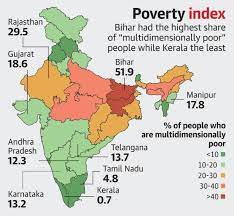01 Dec 2021 National Multidimensional Poverty Index

- NITI Aayog has released Multidimensional Poverty Index (MPI).
- Earlier the Global Multidimensional Poverty Index 2021 was released by the United Nations Development Program (UNDP) and the Oxford Poverty and Human Development Initiative (OPHI).
Introduction:
- MPI attempts to measure poverty in many of its dimensions and actually provides current poverty statistics on the basis of per capita consumption expenditure.
- According to the Global MPI 2021, India’s rank is 66th out of 109 countries. The objective of the National MPI Project is to ensure a systematic MPI for India along with a global alliance to prepare comprehensive reform action plans with the goal of improving India’s position in the global MPI ranking.
- It has three equally weighted dimensions – health, education and standard of living.
- These three dimensions are represented by 12 indicators, such as nutrition, school enrolment, school education, drinking water, sanitation, housing, bank accounts etc.
Functions and data:
- A globally accepted and robust methodology developed by the United Nations Development Program (UNDP) and the Oxford Poverty and Human Development Initiative (OPHI) is used to measure the national MPI.
- The baseline report of the National Multidimensional Poverty Index is based on the National Family Health Survey-4 (NFHS-4), which was implemented in the year 2015-16.
- Use of NFHS-4 data serves as a useful resource on baseline multidimensional poverty to measure the situation before large scale launch of various central government schemes.
- The objective of NFHS-4 is to take measures to improve housing, drinking water, sanitation, electricity, cooking fuel, financial inclusion, school enrollment, nutrition, maternal and child health etc.
- It should be noted, however, that preliminary observations obtained from the NFHS-5 data factsheet suggest improvements in access to clean cooking fuel, sanitation and electricity, which indicate a lack.
Index Conclusions:
Poverty Level:
- Bihar state has the highest population-to-poverty ratio, followed by Jharkhand and Uttar Pradesh with multidimensional poverty levels.
- The state of Kerala recorded the lowest poverty level in its population, followed by Puducherry, Lakshadweep, Goa and Sikkim.
Malnourished people:
- Bihar has the highest number of malnourished people, followed by Jharkhand, Madhya Pradesh, Uttar Pradesh and Chhattisgarh.
Importance of Index:
Contribution to setting up public policy tools:
- The development of the index makes a significant contribution towards establishing a public policy tool that monitors multidimensional poverty, informing evidence-based and focused interventions to ensure that no one lags behind in the race for development.
To present a holistic picture of poverty:
- It presents a holistic picture of poverty in the country, as well as a more in-depth analysis of those regions – state or districts, and specific regions that serve as a complement to the existing monetary poverty statistics.
- Helpful in achieving the Sustainable Development Goals:
- It contributes towards measuring progress towards Goal-2 of the Sustainable Development Goals (SDGs), which aims to reduce the proportion of men, women and children of all ages living in poverty to have to do at least half.
Related Government Initiatives:
- National Rural Livelihoods Mission (NRLM)
- Mahatma Gandhi National Rural Employment Guarantee Act 2005 (MNREGA)
- Pradhan Mantri Awas Yojana- Gramin (PMAY-G)
- Public Distribution System (PDS)
- Pradhan Mantri Awas Yojana (PMAY)
- Jal Jeevan Mission (JJM)
- Swachh Bharat Mission (SBM)
- Pradhan Mantri Sahaj Bijli Har Ghar Yojana (Saubhagya)
- Pradhan Mantri Ujjwala Yojana (PMUY)
Download yojna ias daily current affairs 1 December 2021


No Comments